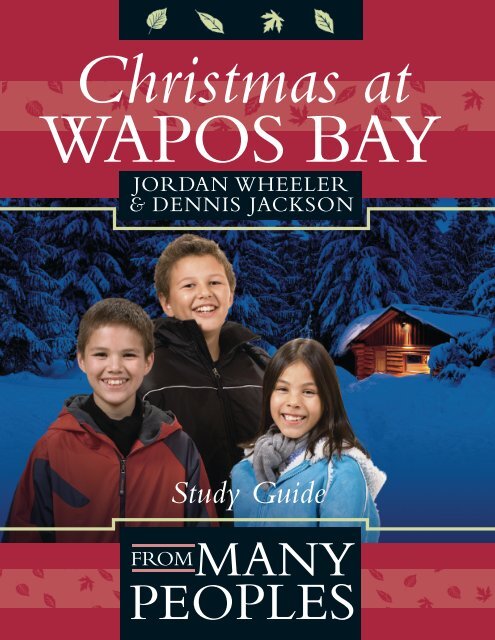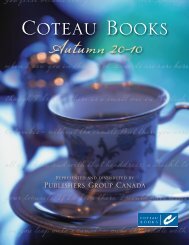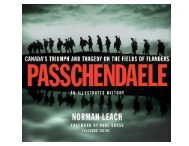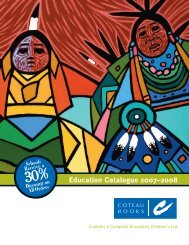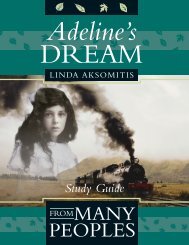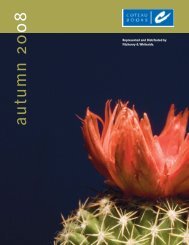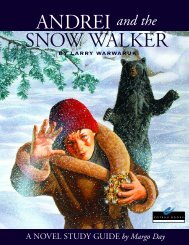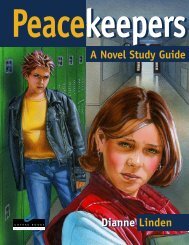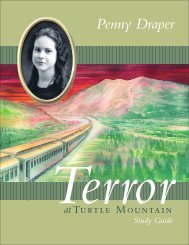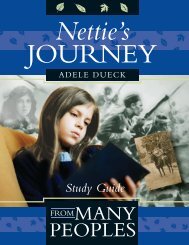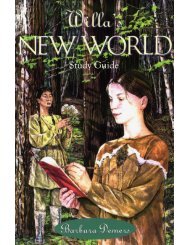Christmas at Wapos Bay - Coteau Books
Christmas at Wapos Bay - Coteau Books
Christmas at Wapos Bay - Coteau Books
- No tags were found...
You also want an ePaper? Increase the reach of your titles
YUMPU automatically turns print PDFs into web optimized ePapers that Google loves.
<strong>Christmas</strong> <strong>at</strong><br />
WAPOS BAY<br />
JORDAN WHEELER<br />
& DENNIS JACKSON<br />
FROM<br />
Study Guide<br />
MANY<br />
PEOPLES
<strong>Christmas</strong> <strong>at</strong><br />
WAPOS BAY<br />
JORDAN WHEELER<br />
& DENNIS JACKSON<br />
A Novel Study Guide<br />
by Jennifer Hingley
© <strong>Coteau</strong> <strong>Books</strong>, 2006.<br />
Teachers have permission from the author and publisher to make copies of this<br />
guide for personal classroom use, personal reference, and student use.<br />
ISBN: 978-1-55050-328-9<br />
The traditional Cree story Kikawinaw is published by the Sask<strong>at</strong>chewan Indian<br />
Cultural College as part of the instructional kit,“Practicing the Law of Circular<br />
Interaction: First N<strong>at</strong>ion Environment and Conserv<strong>at</strong>ion Principles.” It is used here<br />
with the permission of the Sask<strong>at</strong>chewan Indian Cultural College.<br />
Cover images: background: ©FirstLight, models: photographed by Paul Austring,<br />
l to r: Frederick Daigneault, Justin James Levi Challis, and Ember Jade LaRose.<br />
Cover montage and design by Duncan Campbell.<br />
Study Guide design by Karen Steadman.<br />
Printed and bound in Canada.<br />
2517 Victoria Ave.<br />
Regina, Sask<strong>at</strong>chewan<br />
Canada S4P 0T2<br />
The publisher gr<strong>at</strong>efully acknowledges the financial support of its publishing program<br />
by: the Sask<strong>at</strong>chewan Arts Board, the Canada Council for the Arts, the Government<br />
of Canada through the Book Publishing Industry Development Program (bpidp), the<br />
City of Regina Arts Commission, the Sask<strong>at</strong>chewan Cultural Industries Development<br />
Fund, Sask<strong>at</strong>chewan Culture Youth and Recre<strong>at</strong>ion, SaskCulture Inc., Sask<strong>at</strong>chewan<br />
Centennial 2005, Sask<strong>at</strong>chewan Lotteries, and the Lavonne Black Memorial Fund.
Table of Contents<br />
Introduction . . . . . . . . . . . . . . . . . . . . . . . . . . . . . . . . . . . . . . . . . . . . . . . . . . .1<br />
Before You Read the Novel . . . . . . . . . . . . . . . . . . . . . . . . . . . . . . . . . . . . . . . .3<br />
Chapter One . . . . . . . . . . . . . . . . . . . . . . . . . . . . . . . . . . . . . . . . . . . . . . . . . .7<br />
Chapter Two . . . . . . . . . . . . . . . . . . . . . . . . . . . . . . . . . . . . . . . . . . . . . . . . . .12<br />
Chapter Three . . . . . . . . . . . . . . . . . . . . . . . . . . . . . . . . . . . . . . . . . . . . . . . . .13<br />
Chapter Four . . . . . . . . . . . . . . . . . . . . . . . . . . . . . . . . . . . . . . . . . . . . . . . . . .15<br />
Chapter Five . . . . . . . . . . . . . . . . . . . . . . . . . . . . . . . . . . . . . . . . . . . . . . . . . .16<br />
Chapter Six . . . . . . . . . . . . . . . . . . . . . . . . . . . . . . . . . . . . . . . . . . . . . . . . . . .17<br />
Chapter Seven . . . . . . . . . . . . . . . . . . . . . . . . . . . . . . . . . . . . . . . . . . . . . . . . .19<br />
Chapter Eight . . . . . . . . . . . . . . . . . . . . . . . . . . . . . . . . . . . . . . . . . . . . . . . . .20<br />
Chapter Nine . . . . . . . . . . . . . . . . . . . . . . . . . . . . . . . . . . . . . . . . . . . . . . . . .21<br />
Chapter Ten . . . . . . . . . . . . . . . . . . . . . . . . . . . . . . . . . . . . . . . . . . . . . . . . . . .22<br />
Chapter Eleven . . . . . . . . . . . . . . . . . . . . . . . . . . . . . . . . . . . . . . . . . . . . . . . .23<br />
Chapter Twelve . . . . . . . . . . . . . . . . . . . . . . . . . . . . . . . . . . . . . . . . . . . . . . . .24<br />
Concluding Activities . . . . . . . . . . . . . . . . . . . . . . . . . . . . . . . . . . . . . . . . . . . .25
Introduction<br />
Plot Summary<br />
Talon and Raven and their cousin T-Bear are visiting their grandf<strong>at</strong>her <strong>at</strong> his cabin on a northern<br />
lake.They’ve never lived in the bush, but they want to learn the old ways of surviving on the<br />
land. It’s <strong>Christmas</strong>, and the whole extended family is coming to Mushom’s cabin. Everyone is<br />
looking forward to it. But because of a terrible forest fire, hunting is poor this winter.There may<br />
not be enough food for <strong>Christmas</strong>.<br />
The children decide to help by going hunting.They don’t understand how unprepared they<br />
are or wh<strong>at</strong> dangers they face.They get lost, forcing Mushom to rescue them. But when they find<br />
their grandf<strong>at</strong>her collapsed in the bush, it is the children who have to bring Mushom safely home.<br />
Organiz<strong>at</strong>ion<br />
This guide provides educ<strong>at</strong>ors with a variety of activities intended to enhance the understanding<br />
of the novel <strong>Christmas</strong> <strong>at</strong> <strong>Wapos</strong> <strong>Bay</strong>. A number of instructional str<strong>at</strong>egies will be used to build on<br />
the students’ knowledge of Northern Cree people while developing stronger reading and comprehension<br />
skills. Each teacher using this guide will be able to choose those exercises th<strong>at</strong> best<br />
suit the needs of her or his students.We encourage you to add other activities as well.<br />
Three c<strong>at</strong>egories of responses are offered for each chapter, Preparing to Read,After Reading, and<br />
Extending the Reading.<br />
Preparing to Read<br />
This section in the study of each chapter has activities th<strong>at</strong> require class discussion and personal<br />
reflection. It is intended to help the students anticip<strong>at</strong>e the coming chapter.<br />
After Reading<br />
This section provides discussion questions th<strong>at</strong> target important events and themes in the book.<br />
Please feel free to add other questions of your own. Encourage your students to develop questions<br />
about the reading th<strong>at</strong> their classm<strong>at</strong>es could answer.<br />
Extending the Reading<br />
These activities are intended to involve the students in wh<strong>at</strong> they’ve read and to help them rel<strong>at</strong>e<br />
the story to their own world.<br />
<strong>Christmas</strong> <strong>at</strong><br />
WAPOS BAY<br />
© <strong>Coteau</strong> <strong>Books</strong>, 2006. Teachers have permission from the author and publisher to make<br />
copies of this guide for personal classroom use, personal reference, and student use.<br />
1
Connections to the Sask<strong>at</strong>chewan Curriculum Guides<br />
The essential strands of the Sask<strong>at</strong>chewan Learning Language Arts Curriculum (Listening,<br />
Speaking, Reading,Writing,Viewing, and Representing) will be developed by utilizing this study<br />
guide. This novel could be taught within a social, cultural, and historical context with direct connections<br />
to the Grade Five Identity Social Studies unit and the Grade Five Science unit on<br />
Resources.<br />
One of the found<strong>at</strong>ional objectives of the Sask<strong>at</strong>chewan Learning Evergreen Curriculum is<br />
the inclusion of First N<strong>at</strong>ions, Métis, and Inuit content and perspectives. This novel provides a<br />
window into the Northern Cree traditional way of life. Educ<strong>at</strong>ors have the opportunity to engage<br />
their students in listening to and speaking the Northern Cree dialect as well as understanding the<br />
structure and dynamics of Northern Cree families.<br />
Readers’ Response Journals<br />
One of main assessment tools for the use of this study guide is a reader’s response journal.The<br />
educ<strong>at</strong>or will use the journal to assess and evalu<strong>at</strong>e the students’ comprehension of the story. It<br />
will be used to strengthen the students’ writing, as it will be a formal written assignment. It is<br />
important for the teacher to establish the criteria th<strong>at</strong> will be used for evalu<strong>at</strong>ing the responses.<br />
A reader’s response journal is designed to evoke personal responses and connections to liter<strong>at</strong>ure.<br />
The questions posed invite students to think <strong>at</strong> a higher level.The responses are not intended to<br />
be a summary of the story, but r<strong>at</strong>her a reflection of the reader’s interpret<strong>at</strong>ion of the story.<br />
Engaging In the Reading Process<br />
The teacher may use a variety of str<strong>at</strong>egies to engage the students in reading: teacher reading<br />
aloud; oral reading as a large group; silent or independent reading; group reading or paired reading.To<br />
support student learning and success it is recommended th<strong>at</strong> prior to calling on a student<br />
to read, the teacher assign the student the portion th<strong>at</strong> they will be responsible for reading.This<br />
will give the student an opportunity to rehearse his or her reading and feel more confident when<br />
reading aloud to peers.<br />
From Many Peoples<br />
<strong>Christmas</strong> <strong>at</strong> <strong>Wapos</strong> <strong>Bay</strong> is part of the From Many Peoples series published by <strong>Coteau</strong> <strong>Books</strong>.<br />
Originally developed as a celebr<strong>at</strong>ion of Sask<strong>at</strong>chewan’s Centennial in 2005, the stories in this<br />
series illumin<strong>at</strong>e life in the province from the viewpoints of young people from different cultural<br />
groups. Study guides for the From Many Peoples novels can be downloaded free of charge from<br />
the <strong>Coteau</strong> <strong>Books</strong> Web site: www.coteaubooks.com. For more inform<strong>at</strong>ion about this book, and<br />
the other books in the From Many Peoples series, please check out our dedic<strong>at</strong>ed Web site <strong>at</strong><br />
www.coteaubooks.com/frommanypeoples.html.<br />
© <strong>Coteau</strong> <strong>Books</strong>, 2006. Teachers have permission from the author and publisher to make<br />
copies of this guide for personal classroom use, personal reference, and student use.<br />
2 <strong>Christmas</strong> <strong>at</strong><br />
WAPOS BAY
Before You Read the Novel<br />
The following activities will help students understand the context of this novel.<br />
The Cree Language<br />
The title of the novel is <strong>Christmas</strong> <strong>at</strong> <strong>Wapos</strong> <strong>Bay</strong>. Ask the students if anyone knows the meaning<br />
of the word <strong>Wapos</strong>.<strong>Wapos</strong> means rabbit.<br />
Cre<strong>at</strong>e a list of words with the class for which they would like to know the Cree transl<strong>at</strong>ion.<br />
Then have the students research those words using the Internet. Go to http://www.giftof<br />
languageandculture.ca/ as a resource for this learning activity.There are various Cree resources<br />
available from the Sask<strong>at</strong>chewan Indian Cultural Center, 120 33rd Street East, Sask<strong>at</strong>oon, sk,<br />
s7k 0s2, 306-242-4765 or contact through email http://www.sicc.sk.ca.<br />
This activity is further explained in the Chapter One section of this guide and continued<br />
throughout the reading of the novel.<br />
The teacher may want to arrange for a Cree speaker to visit the classroom to share his or her<br />
knowledge of language with the students. It is proper protocol th<strong>at</strong> when one is asking for something<br />
one must give something in exchange. It would be following protocol if the teacher presented<br />
the guest with an offering of tobacco (this is especially important if the guest is known as<br />
an Elder in the community).Tobacco is considered sacred and is used when offering prayers, in<br />
ceremony, or when g<strong>at</strong>hering plants.The recipient of the tobacco will use it in a sacred manner.<br />
Contact your local cultural center, Friendship Inn, Band Council, or Tribal Council office to connect<br />
with a Cree speaker.<br />
The Cree World View<br />
Kikawinaw – Our Mother Earth<br />
It is important for the teacher and students to understand something of the traditional beliefs of<br />
the Northern Cree people about their rel<strong>at</strong>ionship with Mother Earth.The Cree people have a<br />
strong understanding of the Earth and the cycles of n<strong>at</strong>ure.The Circle symbol is a found<strong>at</strong>ion of<br />
beliefs and children are taught their role in the circle of life. Cree people believe themselves to<br />
be in rel<strong>at</strong>ionship with Mother Earth and th<strong>at</strong> all beings, plants, animals, birds, and people are her<br />
children.The Cree people know th<strong>at</strong> their very survival and existence is dependent on these life<br />
forms.Traditionally, the Elders in the community through storytelling, discovery, or experiential<br />
learning and trial and error teach children these principles. Children are taught with gentleness<br />
and are valued in the community.Today, many Northern Cree children <strong>at</strong>tend school and learn<br />
from a teacher and also have opportunities to learn from Elders in the community.<br />
The story Kikawinaw – Our Mother Earth is written down, but it has been adapted from the<br />
oral tradition of storytelling. It is written unchanged from the way it was told out loud. The<br />
spelling of the word Mushom is different in the story than the novel because of different dialects<br />
and nuances in the Cree language.<br />
<strong>Christmas</strong> <strong>at</strong><br />
WAPOS BAY<br />
© <strong>Coteau</strong> <strong>Books</strong>, 2006. Teachers have permission from the author and publisher to make<br />
copies of this guide for personal classroom use, personal reference, and student use.<br />
3
Read the story Kikawinaw – Our Mother Earth to the students. Have the students respond to<br />
the story by answering the following questions in their Readers’ Response Journals:<br />
<br />
<br />
<br />
Wh<strong>at</strong> do the Neyiawak people call the Earth Why do they have this name for<br />
the earth<br />
Describe how Mushom teaches his grandchildren.Wh<strong>at</strong> is similar or different<br />
between how Mushom teaches and how your grandparents teach you<br />
In wh<strong>at</strong> ways did Mushom say th<strong>at</strong> people are like Mother Earth<br />
This lesson is based on Practicing the Law of Circular Interaction: First N<strong>at</strong>ion Environment<br />
and Conserv<strong>at</strong>ion Principles (Sask<strong>at</strong>chewan Indian Cultural Center http://www.sicc.sk.ca/).This<br />
kit includes videos and a wealth of inform<strong>at</strong>ion and is available from the Sask<strong>at</strong>chewan Indian<br />
Cultural Center.Viewing one of the videos addresses the viewing strand of the Sask<strong>at</strong>chewan<br />
Learning English Language Arts curriculum.<br />
KIKAWINAW – OUR MOTHER EARTH<br />
First Grandchild: “Nimosom, tell us a story please!”<br />
Second Grandchild: “Nimosom, please do!”<br />
The Mosom, Grandpa: “Alright, I’ll tell you a story, but you have to listen and sit quietly!”<br />
First Grandchild: “Yeah! Alright! I’ll go tell the others to come!”<br />
Grandpa Mosom sits quietly, filling his pipe. He sits on the floor, where he has his bedding, near<br />
the he<strong>at</strong>er. He prefers to sleep on the floor, because he is not used to a soft m<strong>at</strong>tress. He also likes<br />
to be near the warm wood he<strong>at</strong>er.<br />
All nine children came, hurrying to try and sit as close to Grandpa Mosom as possible. Some<br />
s<strong>at</strong> on either side of Grandpa Mosom, others s<strong>at</strong> by his feet. Even the two-year old tot, who walks<br />
clumsily, climbed over everyone until she reached her Grandpa’s knee and s<strong>at</strong> herself down.<br />
Grandpa Mosom welcomes her, after all, she is the baby of the family. Her Cree name was special,<br />
she was named Askiy iskwew, Earth Woman (us-key is-qua-oh).<br />
Grandpa Mosom begins: “I will tell you the story of our Mother, our Teacher!”<br />
All the children s<strong>at</strong> in silence, waiting for the story to begin.<br />
“... this story is of a long time ago. My Grandf<strong>at</strong>her told me, my Gre<strong>at</strong>-Gre<strong>at</strong> Grandf<strong>at</strong>her told<br />
him.We are Nehiyawak (nay-hee-ya-wuk) the Crees, the people of Earth.<br />
“We have a special name in the Cree language, when we refer to our Earth, we call Earth,<br />
askiy (us-Key) – Kikawinaw (key-ca-wee-now) which means our Mother Earth.<br />
© <strong>Coteau</strong> <strong>Books</strong>, 2006. Teachers have permission from the author and publisher to make<br />
copies of this guide for personal classroom use, personal reference, and student use.<br />
4 <strong>Christmas</strong> <strong>at</strong><br />
WAPOS BAY
“Each time we pray, we always remember to include ‘askiy-kikawinaw’ our Mother Earth,<br />
because we were born on her, she is the bearer of other life forms such as plants, animals, and<br />
birds.These other life forms are living on her too, so we must not forget to remember th<strong>at</strong> the<br />
plants, animals, and birds are our Brothers.<br />
“Mother Earth is very special to us Nehiyawak (nay-hee-ya-wuk). Mother Earth holds all th<strong>at</strong><br />
lives, including us. But our Mother is also our teacher.<br />
“It was said by our Gre<strong>at</strong>-Gre<strong>at</strong> Grandparents, th<strong>at</strong> it was shown to them, how they are rel<strong>at</strong>ed<br />
to our Mother Earth. A human, a plant, an animal or bird, in many ways, we are similar to<br />
Mother Earth. All life forms need w<strong>at</strong>er to live. It is because a human and other life forms are<br />
made more of liquids, just like Mother Earth is made more of w<strong>at</strong>er.<br />
“It was also said th<strong>at</strong> this flow of w<strong>at</strong>er is very important, because the w<strong>at</strong>er channels flow<br />
throughout the Earth and so does our blood, carried by arteries and veins, it too flows throughout<br />
our bodies. If something bad gets into the w<strong>at</strong>er flow, it will affect all the Earth. In humans,<br />
if your blood is affected, your whole being will be affected too.<br />
“Now, I will tell you the story about Kikawinaw (key-ca-wee-now) Mother Earth. In our<br />
gre<strong>at</strong>, gre<strong>at</strong> ancestor’s past, long, long ago, this story comes. It was told to us by our ancestors, th<strong>at</strong><br />
in the beginning of time, there existed a Power so mighty, th<strong>at</strong> it cre<strong>at</strong>ed the Earth as we know<br />
it today.<br />
“We, Nehiyawak (Nay-hee-ya-wuk) were taught by our ancestors, th<strong>at</strong> our Mother is the<br />
Earth, because we were born on her, as did our brothers the animals, the birds, the aqu<strong>at</strong>ic and<br />
the small life.The plants are part of Mother Earth, it is from this source, we are all nurtured. In<br />
our language, we say Kikawinaw (key-ca-wee-now), which means our Mother.<br />
“Each plant th<strong>at</strong> grows on Mother Earth, has a purpose here on Earth. Most life forms depend<br />
on the plant, directly or indirectly. Some animals, whether the aqu<strong>at</strong>ic, the winged or the small<br />
life, each may depend on the plant as their main food source. Meanwhile, animals such as our<br />
brother wolf, do not live on plant life.The food he c<strong>at</strong>ches e<strong>at</strong>s plants, like the rabbit, the prairie<br />
chicken, the squirrels or the deer. Brother wolf e<strong>at</strong>s me<strong>at</strong>. If there is no plant life for the plant<br />
e<strong>at</strong>ers, they will either move until they find food, or they could die. So when these plant e<strong>at</strong>ing<br />
animals move, brother wolf has to follow. As brother wolf knows, to survive, he has to hunt where<br />
there is food.This is the way, all life depends on each other.<br />
“Kikawinaw (key-ca-wee-now) our Mother Earth has n<strong>at</strong>ural elements, forces and growth,<br />
and it is these combin<strong>at</strong>ions th<strong>at</strong> make plants grow. In Cre<strong>at</strong>ion, it was said th<strong>at</strong> Kikawinaw<br />
(Mother Earth) has the cycle of rebirth, renewal and de<strong>at</strong>h, and there is also the good and the<br />
bad. It is this balance th<strong>at</strong> makes harmony.<br />
“Then finally, there is the birth of the humans. Being her last and the youngest child, the<br />
humans are the most spoiled, most dependant and weakest.The human’s only survival tool, will<br />
be their thought process. So to this day, it is the human thought process, th<strong>at</strong> is changing all of<br />
Cre<strong>at</strong>ion.The values toward Kikawinaw (Mother Earth) have changed.<br />
“Once, long ago, all humans were humble people. All humanity was once equal to other life<br />
forms, cre<strong>at</strong>ing an interrel<strong>at</strong>edness and a balance th<strong>at</strong> is no more.<br />
“In view of all cre<strong>at</strong>ion, humanity is the weakest. We say this, because our ancestors have<br />
shown us, th<strong>at</strong> we are the most dependant.We are weak, because our thinking is our weak link.<br />
We are dependant, because our place in the hierarchy, shows us we cannot continue to live, or<br />
<strong>Christmas</strong> <strong>at</strong><br />
WAPOS BAY<br />
© <strong>Coteau</strong> <strong>Books</strong>, 2006. Teachers have permission from the author and publisher to make<br />
copies of this guide for personal classroom use, personal reference, and student use.<br />
5
survive, without our Brothers; the animals, the aqu<strong>at</strong>ic, the winged, the small life, the plants and<br />
most of all, Mother Earth.This is why we humble ourselves as people, and everything is above us.<br />
We need Mother Earth and all th<strong>at</strong> existed before us, to continue in the cycle of life.This is why<br />
I tell you, my Grandchildren, respect n<strong>at</strong>ure, tre<strong>at</strong> Mother Earth with care and gentleness, for all<br />
our Earth things to work in a cycle.The cycles of life, seasons, w<strong>at</strong>er, rock and we<strong>at</strong>her are all a<br />
part of the wonders of Mother Earth.<br />
“Each year, Kikawinaw (Mother Earth) goes through changes, in the seasons, just like we do.<br />
Our bodies go through changes too. Kikawinaw’s (Mother Earth) n<strong>at</strong>ural forces such as the<br />
winds, also goes through sudden changes, just as we do. Our emotions change in a second.<br />
“Kikawinaw (Mother Earth) gives new life to the grass, trees, shrubs, and all green growth. So<br />
do our women, they are special because only they can give birth and bear children, just like our<br />
Mother Earth.<br />
“Kikawinaw’s (Mother Earth) life forms, decompose and return back to the soil eventually, so<br />
does Man and everything th<strong>at</strong> is n<strong>at</strong>ural.This is the life cycle. Our Mother Earth is warm, and<br />
humans are warm blooded as well.<br />
“My Grandchildren, there are many ways th<strong>at</strong> we humans are similar to our Mother Earth.<br />
“It is up to us to take care of Kikawinaw (key-ca-wee-now), our Mother Earth and her children.<br />
We have to allow Kikawinaw’s (key-ca-wee-now) life forms to balance. Humanity has to<br />
allow n<strong>at</strong>ural balance to occur in the animals, birds, other small life and the plants, by allowing<br />
Mother Earth’s life forms to flourish n<strong>at</strong>urally. Humanity needs to keep track of their behaviour<br />
toward their Mother.”<br />
Children’s Stories of the Northern Cree<br />
Share one or more of the following stories to help the students better understand and picture the<br />
life of the Northern Cree people in a traditional setting.<br />
<br />
<br />
Caribou Song, by Thomson Highway, illustr<strong>at</strong>ions by Brian Deines. HarperCollins<br />
Publishers, 2001. (English and Cree).<br />
Dragonfly Kites, by Thomson Highway, illustr<strong>at</strong>ions by Brian Deines. HarperCollins<br />
Publishers, 2002. (English and Cree).<br />
© <strong>Coteau</strong> <strong>Books</strong>, 2006. Teachers have permission from the author and publisher to make<br />
copies of this guide for personal classroom use, personal reference, and student use.<br />
6 <strong>Christmas</strong> <strong>at</strong><br />
WAPOS BAY
Chapter One: First Light<br />
(Pages 1–11)<br />
Summary<br />
T-Bear,Talon, and Raven are asleep. Mushom is up with the sun and wakes the children gently<br />
so th<strong>at</strong> they may begin the day. Outside the sled dogs are waking up too. Mushom and the children<br />
are eagerly anticip<strong>at</strong>ing the arrival of their families <strong>at</strong> the cabin to celebr<strong>at</strong>e <strong>Christmas</strong>.The<br />
children are worried about having enough food for <strong>Christmas</strong>. If they do not have enough, then<br />
the large family will have to separ<strong>at</strong>e and they will not be able to celebr<strong>at</strong>e together. Uncle Peter<br />
arrives and they prepare to set out on the trapline, to check the traps and to hunt.<br />
Preparing to Read<br />
<br />
<br />
kwl: Lead the students in a kwl activity.This is an exercise th<strong>at</strong> engages the students’<br />
prior knowledge about a topic. An example of a kwl chart is provided on<br />
the following pages.<br />
Ask the students wh<strong>at</strong> they know about the traditional Northern Cree way of<br />
Life. Record their responses on the chart paper. Next ask the students wh<strong>at</strong> they<br />
want to learn and record those responses on the flip chart.<br />
After Reading<br />
The teacher will read the chapter aloud to the students. After reading, the students will respond<br />
to these questions in their Readers’ Response Journals.<br />
Describe Mushom’s character and provide examples from the story to support<br />
your ideas.<br />
Wh<strong>at</strong> is the situ<strong>at</strong>ion facing the family th<strong>at</strong> is causing the children to be worried<br />
<strong>Christmas</strong> <strong>at</strong><br />
WAPOS BAY<br />
© <strong>Coteau</strong> <strong>Books</strong>, 2006. Teachers have permission from the author and publisher to make<br />
copies of this guide for personal classroom use, personal reference, and student use.<br />
7
Extending the Reading<br />
<br />
<br />
<br />
Character Development.<br />
• It is important for the reader to understand the characters in the<br />
story. Have the students begin a character chart th<strong>at</strong> identifies a<br />
character and his or her characteristics supported by clues in the<br />
story.Two possible form<strong>at</strong>s for doing this are provided on the following<br />
pages.The students will add to the chart as the story and<br />
characters develop. Characters introduced so far are: Mushom,<br />
Freedom,T-Bear,Talon, Raven, Shadow, and Uncle Peter.<br />
English – Cree Dictionary.<br />
• Have the students cre<strong>at</strong>e a dictionary with English words in one<br />
column and Cree transl<strong>at</strong>ions in a second. Ask the students to find<br />
the meaning of wanska and nistow. Throughout the study of this<br />
novel there will be opportunities to add words to the dictionary.<br />
Research Project.<br />
• Have the students select a topic to investig<strong>at</strong>e regarding the traditional<br />
Cree way of life as described in the story. Consider researching:<br />
sled dogs and racing; trapping; forest fires and the impact on<br />
the environment; hunting; the role of family; Northern Cree territory;<br />
entertainment, educ<strong>at</strong>ion, and recre<strong>at</strong>ion; language and cultural<br />
practices. It is important for the students to gain this inform<strong>at</strong>ion<br />
from a Cree perspective, if it is to be meaningful to the story. To<br />
gain the Northern Cree perspective, use resources written by<br />
Northern Cree people or interview a northern Cree person.<br />
Outline the expect<strong>at</strong>ions, assessment criteria, and timelines of the<br />
project with students prior to beginning the project.<br />
© <strong>Coteau</strong> <strong>Books</strong>, 2006. Teachers have permission from the author and publisher to make<br />
copies of this guide for personal classroom use, personal reference, and student use.<br />
8 <strong>Christmas</strong> <strong>at</strong><br />
WAPOS BAY
Topic:<br />
K<br />
Wh<strong>at</strong> do we know<br />
W<br />
Wh<strong>at</strong> do we want to know<br />
L<br />
Wh<strong>at</strong> have we learned<br />
<strong>Christmas</strong> <strong>at</strong><br />
WAPOS BAY<br />
© <strong>Coteau</strong> <strong>Books</strong>, 2006. Teachers have permission from the author and publisher to make<br />
copies of this guide for personal classroom use, personal reference, and student use.<br />
9
Character Development<br />
Fill in the chart with inform<strong>at</strong>ion found in the story.<br />
Character Character Trait Clues th<strong>at</strong> Prove this Trait Page<br />
10 © <strong>Coteau</strong> <strong>Books</strong>, 2006. Teachers have permission from the author and publisher to make <strong>Christmas</strong> <strong>at</strong><br />
copies of this guide for personal classroom use, personal reference, and student use. WAPOS BAY
Character Development<br />
Choose a character from the story and write his/her name in the centre oval.Write four character<br />
traits in the joining smaller ovals, and then following the arrows, write evidence for each trait<br />
in the large ovals. Remember to use page numbers for reference.<br />
<strong>Christmas</strong> <strong>at</strong><br />
WAPOS BAY<br />
© <strong>Coteau</strong> <strong>Books</strong>, 2006. Teachers have permission from the author and publisher to make<br />
copies of this guide for personal classroom use, personal reference, and student use.<br />
11
Chapter Two: Nets and Traps<br />
(Pages 12–20)<br />
Summary<br />
Mushom, the children, and Uncle Peter set out to check on the traps and c<strong>at</strong>ch up with Auntie<br />
Anne (Peter’s wife). Mushom takes the time to teach Talon and T-Bear about checking traps and<br />
hunting. Uncle Peter and Raven go pick up Auntie Anne.Auntie Anne expresses concern about<br />
Mushom’s well-being. Mushom experiences some pain but hides it from the two boys.<br />
Preparing to Read<br />
In the previous chapter, the setting of the story was introduced. The setting is very important<br />
because much of the activity occurs in n<strong>at</strong>ure. Have the students cre<strong>at</strong>e a visual of the setting as<br />
described in the story.Wh<strong>at</strong> are the key elements Have the students close their eyes and imagine<br />
th<strong>at</strong> they are in the setting of the story.Wh<strong>at</strong> would they see Hear Smell Feel Once they<br />
have imagined the setting they can then cre<strong>at</strong>e a concrete example by drawing, painting, or making<br />
a diorama to illustr<strong>at</strong>e their interpret<strong>at</strong>ion of the setting of the story.<br />
After Reading<br />
Readers’ Response Journals<br />
Wh<strong>at</strong> does Mushom teach his grandchildren about hunting<br />
Explain wh<strong>at</strong> you think Mushom means when he says,“Wh<strong>at</strong> you do to one animal<br />
affects them all, including yourself.”<br />
Why is Auntie Anne worried about Mushom Wh<strong>at</strong> does Uncle Peter tell her so<br />
th<strong>at</strong> she will not worry<br />
Extending the Reading<br />
<br />
<br />
Character Development.<br />
• Have the students upd<strong>at</strong>e their character charts.Wh<strong>at</strong> new characters<br />
were introduced in the story and wh<strong>at</strong> new inform<strong>at</strong>ion did<br />
we learn about the other characters<br />
Research.<br />
• Allow students an opportunity to work on their research project.<br />
© <strong>Coteau</strong> <strong>Books</strong>, 2006. Teachers have permission from the author and publisher to make<br />
copies of this guide for personal classroom use, personal reference, and student use.<br />
12 <strong>Christmas</strong> <strong>at</strong><br />
WAPOS BAY
Chapter Three: Burnt Trees and the Deer<br />
(Pages 21-33)<br />
Summary<br />
T-Bear,Talon, and Mushom set out into the bush.As they go along, the impact of the forest fire<br />
becomes more evident to the boys.They are surrounded by burnt trees and they see few animals.<br />
They have a deeper sense of respect as they begin to understand the amount of work it takes to<br />
live off the land. Mushom continues to share stories th<strong>at</strong> his Mushom and f<strong>at</strong>her told him.As the<br />
boys’ hunger grows, so does their concern about having enough food for the family. Meanwhile<br />
Raven spends time with Auntie Anne and Uncle Peter. At the end of the chapter they spot a deer<br />
and they all feel hopeful about the prospect of shooting a deer for their family.<br />
Preparing to Read<br />
In Chapter Two,T-Bear comments th<strong>at</strong> Raven asks too many questions. Mushom chuckles and<br />
says th<strong>at</strong> it’s good to ask questions.“Th<strong>at</strong>’s part of how you learn,” he says. Have the students pair<br />
up and cre<strong>at</strong>e a list of questions about topics th<strong>at</strong> they have always wanted to learn more about.<br />
Each person must share one question with the class and a brief explan<strong>at</strong>ion about why they are<br />
curious about th<strong>at</strong> topic.This activity is designed to strengthen the students’ listening and speaking<br />
skills.<br />
After Reading<br />
Readers’ Response Journals<br />
In the Cree tradition, it is very important th<strong>at</strong> respect be shown to Elders. How<br />
do each of the children in the story show respect for Mushom, Auntie Anne, and<br />
Uncle Peter<br />
Wh<strong>at</strong> are some ways th<strong>at</strong> the forest fire has affected the environment<br />
As T-Bear and Talon spend time with Mushom, their respect for him deepens.<br />
They begin to understand how much work it takes to live off the land.Wh<strong>at</strong><br />
skills are necessary to live off the land Wh<strong>at</strong> qualities does living like this<br />
develop in a person<br />
Would you ever want to experience this lifestyle Why or why not Wh<strong>at</strong> do you<br />
think you would learn about yourself by living in this way<br />
<strong>Christmas</strong> <strong>at</strong><br />
WAPOS BAY<br />
© <strong>Coteau</strong> <strong>Books</strong>, 2006. Teachers have permission from the author and publisher to make<br />
copies of this guide for personal classroom use, personal reference, and student use.<br />
13
Extending the Reading<br />
<br />
<br />
<br />
<br />
Character Development.<br />
• Have the students add to their character charts. Remind them th<strong>at</strong><br />
they are to support their ideas with evidence from the story.<br />
Sharing an Opinion.<br />
• Have the students write a paragraph explaining their opinions on<br />
hunting. Cre<strong>at</strong>e an open discussion about hunting. Cre<strong>at</strong>e a T-chart.<br />
List the reasons why people hunt and don’t hunt. Encourage the<br />
students to listen to each other’s ideas and beliefs without arguing.<br />
Among Cree people it is considered reprehensible to try to make<br />
somebody else believe wh<strong>at</strong> you do. R<strong>at</strong>her it is more important to<br />
listen respectfully and allow people to express themselves.<br />
Research.<br />
• Allow students time to work on their research projects.<br />
English – Cree Dictionary.<br />
• Wh<strong>at</strong> is the transl<strong>at</strong>ion for tenigi Find the Cree word for deer, fish,<br />
w<strong>at</strong>er, trees and family.<br />
© <strong>Coteau</strong> <strong>Books</strong>, 2006. Teachers have permission from the author and publisher to make<br />
copies of this guide for personal classroom use, personal reference, and student use.<br />
14 <strong>Christmas</strong> <strong>at</strong><br />
WAPOS BAY
Chapter Four:The Island<br />
(Pages 34–40)<br />
Summary<br />
Mushom takes aim <strong>at</strong> the deer and misses. He is experiencing pain in his side and blurry vision.<br />
They track the animal to an island.They spot the deer, but Mushom is unable to take aim because<br />
of his blurry vision.The boys are now concerned about Mushom.They know th<strong>at</strong> something is<br />
wrong but they do not know wh<strong>at</strong> to do.<br />
Preparing to Read<br />
At the end of the previous chapter, they spot a deer. Ask students to predict wh<strong>at</strong> will happen.<br />
Will they get the deer Why do you think th<strong>at</strong><br />
After Reading<br />
Readers’ Response Journals<br />
How does Mushom know where the deer is<br />
Wh<strong>at</strong> do you think is wrong with Mushom<br />
Mushom says,“There is a reason the Cre<strong>at</strong>or sent you boys here.Your mushom is<br />
getting too old for this now.”Wh<strong>at</strong> does this st<strong>at</strong>ement reveal about Mushom’s<br />
character<br />
Extending the Reading<br />
<br />
Research.<br />
• Allow students time to work on research projects.<br />
<strong>Christmas</strong> <strong>at</strong><br />
WAPOS BAY<br />
© <strong>Coteau</strong> <strong>Books</strong>, 2006. Teachers have permission from the author and publisher to make<br />
copies of this guide for personal classroom use, personal reference, and student use.<br />
15
Chapter Five: More Tracks<br />
(Pages 41–49)<br />
Summary<br />
Uncle Peter, Auntie Anne, and Raven head back to Mushom’s cabin and see th<strong>at</strong> the rest of the<br />
family has arrived. Sarah and Alphonse are Raven and Talon’s parents; Jacob is Mushom’s son and<br />
T-Bear’s f<strong>at</strong>her, and Kokum Rosalie is Mushom’s wife and the mother of Sarah and Jacob. It<br />
becomes clear th<strong>at</strong> Jacob does not agree with the traditional way of life. He and Uncle Peter especially<br />
disagree on this. Meanwhile, back in the bush, Mushom,T-Bear, and Talon discover moose<br />
tracks. As it is getting l<strong>at</strong>e, Mushom says th<strong>at</strong> they must go back to the cabin. Mushom also<br />
observes clouds on the horizon.<br />
Preparing to Read<br />
Have the students discuss a special tradition in their family and ask this question: Is it important<br />
for families to have regular reunions and g<strong>at</strong>herings Explain why or why not.<br />
After Reading<br />
Readers’ Response Journals<br />
Wh<strong>at</strong> does Jacob,T-Bear’s f<strong>at</strong>her, think about living on the trapline Why do you<br />
think he feels this way Do you agree with him Why or why not<br />
Describe Kokum Rosalie’s feelings about the city. Is there some truth to wh<strong>at</strong> she<br />
thinks Explain your thinking.<br />
Wh<strong>at</strong> does T-Bear think about the deer Wh<strong>at</strong> does Mushom teach T-Bear about<br />
his kind of thinking and <strong>at</strong>titude<br />
Wh<strong>at</strong> does Talon do <strong>at</strong> the end of the chapter Why would he do this<br />
Extending the Reading<br />
<br />
<br />
Character Development.<br />
• Add the new characters to the chart with a comment on each character<br />
supported by evidence in the story.<br />
Research.<br />
• Continue to work on research projects.<br />
© <strong>Coteau</strong> <strong>Books</strong>, 2006. Teachers have permission from the author and publisher to make<br />
copies of this guide for personal classroom use, personal reference, and student use.<br />
16 <strong>Christmas</strong> <strong>at</strong><br />
WAPOS BAY
Chapter Six:T-Bear’s Plan<br />
(Pages 50–60)<br />
Summary<br />
The family g<strong>at</strong>hers to enjoy freshly-baked bannock and tea. Mushom and the boys arrive safely<br />
<strong>at</strong> the cabin, although they are disappointed with the lack of fish and me<strong>at</strong>.They begin to specul<strong>at</strong>e<br />
about wh<strong>at</strong> they will do if they do not have enough food for the family.T-Bear shares everything<br />
th<strong>at</strong> he has learned from Mushom about living off the land with his f<strong>at</strong>her. Jacob,T-Bear’s<br />
f<strong>at</strong>her, expresses his displeasure <strong>at</strong> the thought of his son earning his way by living off the land.<br />
The discussion ends and the children play in the snow. Mushom leads the family in a prayer to<br />
the Cre<strong>at</strong>or for help and guidance. T-Bear begins to devise a plan for getting the moose and saving<br />
the family from a sad <strong>Christmas</strong>.<br />
Preparing to Read<br />
In Chapter Five,Talon says a prayer for his family. Lead the class in a discussion about prayer.Why<br />
do people pray How do they pray In the traditional Cree way of life, prayer is very important.<br />
Thanks is offered before all significant activities. Is prayer important in your family On wh<strong>at</strong><br />
occasions do you pray To whom<br />
After Reading<br />
Readers’ Response Journals<br />
Describe how Mushom’s family interact with one another.<br />
Wh<strong>at</strong> does Auntie Anne mean when she says,“The animals are telling you to<br />
slow down Cyril” Do you agree with this comment Why or why not<br />
Wh<strong>at</strong> does Mushom teach about living in harmony with the land<br />
Extending the Reading<br />
<br />
<br />
<br />
English – Cree Dictionary.<br />
• Transl<strong>at</strong>e the words Kokum and ekosi. Find the Cree word for<br />
moose, mom, dad, auntie, uncle, mouse, and goose.<br />
Comparisons.<br />
• Talon and T-Bear are cousins and are very different. Cre<strong>at</strong>e a Venn<br />
diagram th<strong>at</strong> explains how they are similar and different. A sample<br />
Venn diagram is given on the following page.<br />
Baking Bannock.<br />
• Have a bannock cook-off. Have the students research a recipe for<br />
bannock. Cre<strong>at</strong>e a day where the class makes bannock and then<br />
have a challenge as to who makes bannock like Auntie Anne.<br />
<strong>Christmas</strong> <strong>at</strong><br />
WAPOS BAY<br />
© <strong>Coteau</strong> <strong>Books</strong>, 2006. Teachers have permission from the author and publisher to make<br />
copies of this guide for personal classroom use, personal reference, and student use.<br />
17
Venn Diagram<br />
© <strong>Coteau</strong> <strong>Books</strong>, 2006. Teachers have permission from the author and publisher to make<br />
copies of this guide for personal classroom use, personal reference, and student use.<br />
18 <strong>Christmas</strong> <strong>at</strong><br />
WAPOS BAY
Chapter Seven: Raven’s Surprise<br />
(Pages 61–68)<br />
Summary<br />
Mushom and Jacob share some time together as they haul w<strong>at</strong>er. They discuss T-Bear’s future.<br />
Mushom recognizes in T-Bear the desire to live with the land. His f<strong>at</strong>her wants him to have a<br />
formal educ<strong>at</strong>ion. He sees no future in the life of a trapper. Mushom would like Jacob to inherit<br />
his trapline.They end their discussion in a quiet, reflective way. Early the next morning,T-Bear<br />
wakes Talon and convinces him to go out and check the traps and track the moose.Talon does<br />
not think th<strong>at</strong> this is a good idea but reluctantly follows T-Bear. To their surprise and dismay,<br />
Raven wakes and insists on joining them. Left with no choice, the boys take Raven along.<br />
Preparing to Read<br />
<br />
Cre<strong>at</strong>e a bulletin board and learning center th<strong>at</strong> focuses on animal tracks. It<br />
would be fun to have the students cre<strong>at</strong>e a cast of a track. For more ideas, follow<br />
this link: http://42explore.com/animaltracks.htm<br />
After Reading<br />
Readers’ Response Journals<br />
<br />
<br />
<br />
Mushom and Jacob do not agree when it comes to T-Bear’s future.Who do you<br />
agree with and why<br />
Why do you think Talon goes along with T-Bear<br />
Raven says th<strong>at</strong> the boys need a referee. Is there anyone in your life th<strong>at</strong> you care<br />
about a gre<strong>at</strong> deal but have difficulty getting along with Explain.<br />
Extending the Reading<br />
<br />
<br />
Character Development.<br />
• Have the students spend some time on their character descriptions.<br />
Trapping.<br />
• Have the students cre<strong>at</strong>e a r<strong>at</strong>ionale for being a trapper. Can a person<br />
make a living in this way How much could they potentially<br />
make Wh<strong>at</strong> training or educ<strong>at</strong>ion does a person need How many<br />
trappers are there in Sask<strong>at</strong>chewan Are there other careers rel<strong>at</strong>ed<br />
to trapping If yes, wh<strong>at</strong> are they<br />
<strong>Christmas</strong> <strong>at</strong><br />
WAPOS BAY<br />
© <strong>Coteau</strong> <strong>Books</strong>, 2006. Teachers have permission from the author and publisher to make<br />
copies of this guide for personal classroom use, personal reference, and student use.<br />
19
Chapter Eight: Green Bait and Pemmican<br />
Sandwiches<br />
(Pages 69–78)<br />
Summary<br />
The children head out to the trapline.They soon discover th<strong>at</strong> there is more to this work than<br />
they originally thought.T-Bear and Talon begin to bicker about how to do things. Back <strong>at</strong> the<br />
cabin, the family cre<strong>at</strong>es a plan for finding the children. Mushom sets out to track the children<br />
and the rest of the men check on the traps.The children soon discover th<strong>at</strong> there is a storm brewing<br />
and there is no way to avoid it.<br />
Preparing to Read<br />
<br />
Have the students predict wh<strong>at</strong> they think will happen in this chapter and explain<br />
how they came to th<strong>at</strong> conclusion.<br />
After Reading<br />
Readers’ Response Journals<br />
Have you ever left without informing your family where you were going Or<br />
have you ever been lost Describe wh<strong>at</strong> happened. How did your family react<br />
Wh<strong>at</strong> were the consequences for you<br />
Describe how Mushom’s family handles conflict.Who do you think is in charge<br />
and why do you think th<strong>at</strong><br />
Extending the Reading<br />
<br />
<br />
<br />
Character Development.<br />
• Have the students continue to develop their character descriptions.<br />
Research.<br />
• The students may continue to work on their research projects.<br />
Survival Kit.<br />
• Have the students put together a survival kit for winter storms.<br />
Decide if the students are to cre<strong>at</strong>e a written inventory or are to<br />
put together a physical kit th<strong>at</strong> includes items necessary for survival.<br />
Allow the students to choose the type of survival kit they would<br />
like to cre<strong>at</strong>e. Is it for a car, a snowmobile, a pedestrian, a crosscountry<br />
skier<br />
© <strong>Coteau</strong> <strong>Books</strong>, 2006. Teachers have permission from the author and publisher to make<br />
copies of this guide for personal classroom use, personal reference, and student use.<br />
20 <strong>Christmas</strong> <strong>at</strong><br />
WAPOS BAY
Chapter Nine:The Storm<br />
(Pages 79–93)<br />
Summary<br />
The children are trapped in the snowstorm.Talon and the dog team head for the shore but come<br />
upon a steep hill. As they struggle to make it up, it becomes clear th<strong>at</strong> they can’t do it.The sled<br />
tips and the children, the dogs, and the supplies are dumped. Freedom, the lead dog, is injured in<br />
the fall.The children set up a shelter and hope to wait out the storm when they discover they<br />
have no m<strong>at</strong>ches to start a fire.They huddle together for warmth in the tent. Meanwhile, back <strong>at</strong><br />
the cabin, the adults worry and wait p<strong>at</strong>iently for the safe return of the children and Mushom.<br />
Preparing to Read<br />
<br />
In this chapter, a blizzard strikes. Ask the students to tell about the worst blizzard<br />
they remember being in. Have them describe a blizzard in terms of the temper<strong>at</strong>ure<br />
and how it affects your vision and your hearing.<br />
After Reading<br />
Readers’ Response Journals<br />
Describe the children’s situ<strong>at</strong>ion.Wh<strong>at</strong> would you do if this happened to you<br />
Wh<strong>at</strong> do you think will happen to Freedom<br />
Describe Kokum Rosalie.Wh<strong>at</strong> is she like How does she handle the situ<strong>at</strong>ion<br />
Do you think this is helpful Explain why or why not<br />
Wh<strong>at</strong> do you think is wrong with Mushom<br />
Extending the Reading<br />
<br />
<br />
<br />
Reading Comprehension.<br />
• This chapter is important as we are reaching the climax of the story.<br />
Have the students review the important events in the story th<strong>at</strong><br />
have led up to this point.<br />
Character Development.<br />
• Add to the character chart.<br />
English – Cree Dictionary.<br />
• Wh<strong>at</strong> are the Cree words for: snow, dog, hurt, blizzard, shelter, and<br />
scared.<br />
<strong>Christmas</strong> <strong>at</strong><br />
WAPOS BAY<br />
© <strong>Coteau</strong> <strong>Books</strong>, 2006. Teachers have permission from the author and publisher to make<br />
copies of this guide for personal classroom use, personal reference, and student use.<br />
21
Chapter Ten: Reunion<br />
(Pages 94-107)<br />
Summary<br />
The children are settled into their shelter when a familiar face enters the tent. Mushom has found<br />
them. He is exhausted and collapses in the tent. He instructs T-Bear to start a fire and then rests.<br />
Raven w<strong>at</strong>ches Mushom and covers him with blankets. She knows th<strong>at</strong> something is wrong and<br />
she is very concerned. Mushom joins the children <strong>at</strong> the fire and says a prayer. He puts sage into<br />
the fire and gives an offering to each child to place on the fire so th<strong>at</strong> the smoke from the sage<br />
will purify them and carry their prayers to the Cre<strong>at</strong>or. T-Bear is feeling very remorseful and<br />
apologizes to Mushom. Mushom encourages him to balance his courage with knowledge.They<br />
recover the sled and prepare to head back to the cabin. On their way they discover moose tracks.<br />
Preparing to Read<br />
<br />
Ask: How are Mushom and Freedom similar characters in this story Support<br />
your ideas with evidence from the story. Use a Venn diagram to compare how<br />
Mushom and Freedom are similar and different.Then discuss:Who is Shadow<br />
similar to<br />
After Reading<br />
Readers’ Response Journals<br />
How does Mushom react when he finds the children Is this the response th<strong>at</strong><br />
you expected<br />
Mushom tells T-Bear,“You have already shown the grandf<strong>at</strong>hers wh<strong>at</strong> you want.<br />
They will listen to your heart and it is up to you to follow it. No one else can do<br />
th<strong>at</strong> for you...your courage is strong.You just need to balance it with good judgment.”Wh<strong>at</strong><br />
do you think this means<br />
Extending the Reading<br />
<br />
Our Special Gifts.<br />
• T-Bear is struggling to determine his identity. He is trying to honour<br />
his spirit.The Cree view is th<strong>at</strong> we have been placed here for a<br />
reason and have been gifted with special talents. It is the work of<br />
being human to honour those gifts and live a good life. Invite the<br />
students to think about their gifts. How do they honour those gifts<br />
and does this influence wh<strong>at</strong> they want to do with their lives<br />
© <strong>Coteau</strong> <strong>Books</strong>, 2006. Teachers have permission from the author and publisher to make<br />
copies of this guide for personal classroom use, personal reference, and student use.<br />
22 <strong>Christmas</strong> <strong>at</strong><br />
WAPOS BAY
Chapter Eleven:Two Deep Bre<strong>at</strong>hs<br />
(Pages 108–123)<br />
Summary<br />
Mushom discovers moose tracks and follows the moose to an island.The children quietly follow<br />
as the storm rages around them.Talon spots the moose and Mushom tries to take aim. His eyes<br />
are blurry, so he asks one of his grandsons to fire the shot.T-Bear takes hold of the rifle and fires<br />
a shot <strong>at</strong> the moose. He is successful and the moose goes down. Mushom falls unconscious.The<br />
children know th<strong>at</strong> something is very wrong with him.They hear him mumble and learn th<strong>at</strong> he<br />
has not been e<strong>at</strong>ing. They know th<strong>at</strong> Mushom needs nourishment. The boys get some of the<br />
moose me<strong>at</strong> for Mushom.Talon carves the me<strong>at</strong>, remembering how Mushom taught him.They<br />
make a soup for Mushom and wake him up so th<strong>at</strong> he can e<strong>at</strong>. Meanwhile back <strong>at</strong> the cabin, the<br />
adults decide to go to a neighbour’s and get his dogsled and set out to find the children. Kookum<br />
Rosalie, Auntie Anne, and Sarah say prayers for a safe return for everyone.<br />
Preparing to Read<br />
Review the plot lines with the students and discuss possible climaxes. Discuss possibilities for the<br />
resolution of different problems in the story.<br />
After Reading<br />
Readers’ Response Journals<br />
How do Talon and T-Bear work together to solve the crisis th<strong>at</strong> they find themselves<br />
in<br />
How does Kokum Rosalie influence the men in the family<br />
Describe the rel<strong>at</strong>ionship th<strong>at</strong> Mushom has with his grandchildren.<br />
Wh<strong>at</strong> do you admire about Mushom Explain.<br />
Extending the Reading<br />
<br />
Elders.<br />
• T-Bear says respectfully to Mushom,“In our culture Elders are<br />
served first.” Have the students write a paragraph th<strong>at</strong> explains how<br />
they view Elders. How do they show respect for Elders Have the<br />
students pair up to discuss the question: Do we show enough<br />
respect for Elders<br />
<strong>Christmas</strong> <strong>at</strong><br />
WAPOS BAY<br />
© <strong>Coteau</strong> <strong>Books</strong>, 2006. Teachers have permission from the author and publisher to make<br />
copies of this guide for personal classroom use, personal reference, and student use.<br />
23
Chapter Twelve:<strong>Wapos</strong> <strong>Bay</strong><br />
(Pages 124–134)<br />
Summary<br />
Jacob and Uncle Peter find the children and Mushom. They are relieved and very proud of<br />
T-Bear for getting his first moose.They know th<strong>at</strong> they must get Mushom back to the cabin to<br />
recover.When they arrive, Kokum Rosalie checks Mushom over.The family is relieved to know<br />
th<strong>at</strong> he will be okay. Jacob,T-Bear’s f<strong>at</strong>her, expresses pride in his son for getting the moose. He<br />
resolves to spend more time <strong>at</strong> the cabin with Mushom.They all settle in to enjoy <strong>Christmas</strong>.<br />
Preparing to Read<br />
Review the main events of the last chapter. Have the students make predictions about the final<br />
outcome of the story.<br />
After Reading<br />
Readers’ Response Journals<br />
Describe how the family feels about T-Bear’s accomplishment. Have you ever felt<br />
th<strong>at</strong> way about somebody in your family Describe your experience.<br />
How do T-Bear and his f<strong>at</strong>her resolve their differences<br />
How does Mushom’s family celebr<strong>at</strong>e <strong>Christmas</strong> Use a Venn diagram to compare<br />
this family celebr<strong>at</strong>ion with a special occasion in your family. How are the<br />
celebr<strong>at</strong>ions similar and different<br />
Extending the Reading<br />
.<br />
<br />
Character Development.<br />
• Add to the character charts.Write a paragraph th<strong>at</strong> describes how<br />
each of the main characters changes as a result of his or her<br />
experiences.<br />
© <strong>Coteau</strong> <strong>Books</strong>, 2006. Teachers have permission from the author and publisher to make<br />
copies of this guide for personal classroom use, personal reference, and student use.<br />
24 <strong>Christmas</strong> <strong>at</strong><br />
WAPOS BAY
Concluding Activities<br />
The following activities are designed to extend the students’ understanding of the novel.<br />
Thinking About the Characters<br />
<br />
<br />
<br />
<br />
Compare yourself to one of the characters in the story.Who are you the most<br />
like Explain.<br />
Have you had an experience th<strong>at</strong> is similar to a character in this story Describe<br />
your experience and explain how it compares to wh<strong>at</strong> happened to the character.<br />
Think about how each of the characters has changed in the story.Who do you<br />
think changed the most Wh<strong>at</strong> do you think caused the change<br />
Which one of the main characters in the story would you most like to be friends<br />
with Why<br />
Thinking About the Story<br />
<br />
<br />
<br />
<br />
<br />
Wh<strong>at</strong> did you learn from reading this novel Review the kwl chart th<strong>at</strong> was<br />
written <strong>at</strong> the beginning of the story. Complete the learned column of the chart.<br />
Wh<strong>at</strong> are the themes of this story Wh<strong>at</strong> did the authors want us to think about<br />
while we were reading this story<br />
Wh<strong>at</strong> did you learn about Northern Cree people by reading this story<br />
Would you enjoy living on the trapline like Mushom Explain why or why not.<br />
How did Mushom’s family cope with the possibility of not having enough food<br />
<strong>at</strong> <strong>Christmas</strong><br />
Showing Wh<strong>at</strong> We Have Learned<br />
The following activities are designed to illustr<strong>at</strong>e wh<strong>at</strong> the students learned in the story.<br />
Illustr<strong>at</strong>e and alphabetize your English – Cree dictionary and present it to the<br />
class<br />
Present your research project.<br />
Cre<strong>at</strong>e a trapper’s challenge.<br />
• Divide the class into groups and have them compete in a variety of<br />
activities: Examples: whose tracks snow relay, tobogganing, sledding,<br />
bannock baking (outside on a stick); orienteering, hauling<br />
wood, tree identifying, best bait recipe.This is meant to be fun as<br />
well as to have the students experience some of the activities in a<br />
trapper’s life.<br />
View the video, <strong>Christmas</strong> <strong>at</strong> <strong>Wapos</strong> <strong>Bay</strong>.<br />
• The students can respond to the video and determine how closely<br />
the video follows the written story.<br />
<strong>Christmas</strong> <strong>at</strong><br />
WAPOS BAY<br />
© <strong>Coteau</strong> <strong>Books</strong>, 2006. Teachers have permission from the author and publisher to make<br />
copies of this guide for personal classroom use, personal reference, and student use.<br />
25
CHECK OUT THE OTHER STUDY GUIDES<br />
IN THIS SERIES.<br />
Available from <strong>Coteau</strong> <strong>Books</strong>.<br />
The Secret of the<br />
Stone House<br />
By Judith Silverthorne<br />
isbn: 978-1-55050-331-9<br />
(Study Guide)<br />
isbn: 978-1-55050-325-8<br />
(Juvenile Novel)<br />
$8.95cn/$7.95us<br />
Nettie’s Journey<br />
By Adele Dueck<br />
isbn: 978-1-55050-329-6<br />
(Study Guide)<br />
isbn: 978-1-55050-322-7<br />
(Juvenile Novel)<br />
$8.95cn/$7.95us<br />
Adeline’s Dream<br />
By Linda Aksomitis<br />
isbn: 978-1-55050-330-2<br />
(Study Guide)<br />
isbn: 978-1-55050-323-4<br />
(Juvenile Novel)<br />
$8.95cn/$7.95us<br />
<strong>Christmas</strong> <strong>at</strong> <strong>Wapos</strong> <strong>Bay</strong> Study Guide<br />
isbn: 978-1-55050-328-9 $9.95cn/$8.95us<br />
To accompany the <strong>Coteau</strong> <strong>Books</strong> juvenile fiction title:<br />
<strong>Christmas</strong> <strong>at</strong> <strong>Wapos</strong> <strong>Bay</strong><br />
isbn: 1-55050-324-1 $8.95cn/$7.95us<br />
Downloadable study guides in pdf form<strong>at</strong> are available <strong>at</strong><br />
www.coteaubooks.com<br />
Amazing stories.Amazing kids.<br />
<strong>Christmas</strong> <strong>at</strong> <strong>Wapos</strong> <strong>Bay</strong> Study Guide<br />
9 781550 503289<br />
1-55050-328-6


